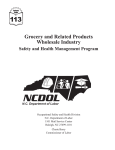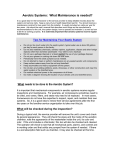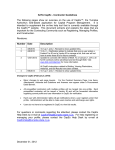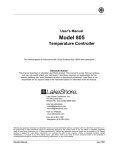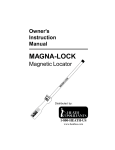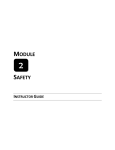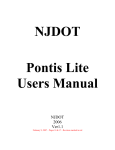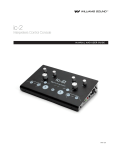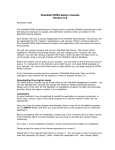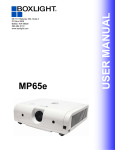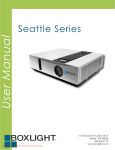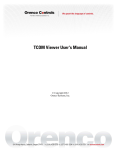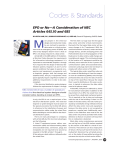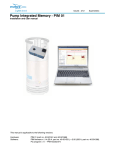Download Addendum No. 2 - Select a reprographer!
Transcript
Freeman Fong Architecture 503-3rd Avenue West Seattle, Washington 98119 Contact: Kevin Kobayashi, Project Coordinator Tel 206.282.8245 Fax 206.283.0895 Addendum No. 2 Issue Date: January 28, 2009 Project: 100 Bed Expansion Mission Creek Corrections Center for Women 3420 NE Sand Hill Road Belfair, Washington 98520 Project No. 08-303 Bid Date: February 5, 2009 To: All Planholders (or Bidders) The following items outline issues discussed during the prebid walk-through meeting at 10:00AM on January 21, 2009 at the Mission Creek Corrections Center for Women in Belfair, Washington. Planholders (or bidders) shall review all items listed below and assess any impact on the proposed work. Any comments or questions shall be submitted to the architect of record immediately. Planholders (or bidders) are responsible for submitting information to all affected sub-bidders, suppliers, etc. All items in this Addendum must be incorporated in the bid proposal. Pre-Bid Walk-Through Participants: Ed Hampton, P.E. – DOC/HQ Tel: 360.725.8345 Email: [email protected] Wayne Pederson – DOC Tel: 360.725.8487 Email: [email protected] Leo Gleason – Department of Corrections Tel: 360.277.2483 Email: [email protected] David Brewer – Department of Corrections – Lieutenant Tel: 360.277.2421 Email: [email protected] Addendum No. 2 - January 29, 2009 Mission Creek Corrections Center for Women Project No. 08-303 Page 2 of 18 Pre-Bid Walk-Through Participants (continued): Kevin Kobayashi – Freeman Fong Architecture Tel: 206.282.8245 Email: [email protected] Daniel Myers – Inventrix Engineering, Inc. Tel: 206.515.4004 Email: [email protected] Patrick Strobridge – Inventrix Engineering, Inc. Tel: 206.515.4004 Email: [email protected] Steve Morales – PACE Engineers Tel: 206.441.1855 Email: [email protected] Jim Bartee – Primo Construction, Inc. Tel: 360.683.5447 Roland Ordona – Primo Construction, Inc. Tel: 360.461.1349 Email: [email protected] Steve Lee – Primo Construction, Inc. Tel: 360.683.5447 ext. 5226 Email: [email protected] Howard Quillin – Swift Plumbing & Heating Tel: 360.297.9592 Email: [email protected] Chris Burke – Kassel Construction Tel: 425.869.3852 Email: [email protected] Karl Hess – Hess Painting Tel: 253.221.1829 Email: [email protected] Addendum No. 2 - January 29, 2009 Mission Creek Corrections Center for Women Project No. 08-303 Page 3 of 18 Edward Manickam – Total Landscape Corporation Tel: 425.766.4760 Email: [email protected] Brian Adams – Total Landscape Corporation Tel: 425.766.4765 Email: [email protected] Dwight Simpson – Huston Excavating, LLC Tel: 360.426.0550 Ron Sisemore – Talbot Excavating Tel: 360.377.1400 Email: [email protected] Gary Goodnight – Goodnight Construction Tel: 360.794.6214 Email: [email protected] Chris Kreger – Goodnight Construction Tel: 425.354.3846 Matt Ames – Abbey Carpet Tel: 360.621.1165 Bill Wolfe – Wolfe Construction, Inc. Tel: 253.537.5184 Email: [email protected] Todd Wolfe – Wolfe Construction, Inc. Tel: 253.537.5184 Douglas Hagen – Heritage Mechanical, Inc. Tel: 360.697.2998 Email: [email protected] Daniel Fischer – Fischer General Contracting, Inc. Tel: 360.697.5402 Michael Elder – Fischer General Contracting, Inc. Tel: 360.697.5402 Addendum No. 2 - January 29, 2009 Mission Creek Corrections Center for Women Project No. 08-303 Page 4 of 18 Jason Heide – Bowers Construction Tel: 360.249.4953 Email: [email protected] Paul Schankel – Bowers Construction Tel: 360.249.4953 Steve Unkie – Unkie Construction Tel: 360.427.5963 Rob Lumsden – RV Associates, Inc. Tel: 360.876.9737 Email: [email protected] Ed Heuss – Heuss Constuction, LLC Tel: 360.479.3377 Email: [email protected] Aaron Hufana – Black Hills Excavating, Inc. Tel: 360.507.4089 Email: [email protected] Craig Engdahl – Tom’s Plumbing Tel: 360.683.8336 Email: [email protected] Daniel Johnson – Aspenland Surveying Tel: 253.857.4265 Email: [email protected] Jeff Moats – WG Clark Construction Tel: 206.624.5244 Email: [email protected] Larry Branam – Discorp (Security) Tel: 210.601.4749 Email: [email protected] Grant Furness – Cobra Roofing Tel: 253.229.7819 Email: [email protected] Addendum No. 2 - January 29, 2009 Mission Creek Corrections Center for Women Project No. 08-303 Page 5 of 18 Dick Johnson – Intermountain Electric Tel: 509.370.1523 Email: [email protected] James Thompson – First Choice Excavation Tel: 360.870.9771 Email: [email protected] Tim Hill – PGH Excavating, Inc. Tel: 253.261.2697 Email: [email protected] Dan Ryan – Waynco Construction Tel: 509.624.3777 Email: [email protected] Daryl Hemley – Ron Hemley Septic Tel: 360.876.6104 Email: [email protected] Todd Anderson – Ron Hemley Septic Tel: 360.876.6104 Email: [email protected] Danny Wilhern – NW Cascade, Inc. Tel: 253.848.2371 Christian Dewey – NW Cascade, Inc. Tel: 253.606.1006 Email: [email protected] Brad Paige – Caseco Associates Tel: 360.876.9213 Scott Swenning – Caseco Associates Tel: 360.876.9213 Email: [email protected] Mark Haley – Merit Construction NW Tel: 258.588.9100 Email: [email protected] Addendum No. 2 - January 29, 2009 Mission Creek Corrections Center for Women Project No. 08-303 Page 6 of 18 Rod Padgett – RV Associates Tel: 360.876.9737 Email: [email protected] Don Hilbert – Corp. Inc. Tel: 503.371.2453 Email: [email protected] Randy Polajzar – Building Intellect, LLC Tel: 425.233.2394 Email: [email protected] Adrian W. Parke – Ebenal General Tel: 360.441.4762 Email: [email protected] Brad Jennings – DK Boos Glass Tel: 360.456.2356 Email: [email protected] John Witrowski – Commercial Structures, Inc. Tel: 206.246.3939 Email: [email protected] Brian Rich – Berschauer Phillips Tel: 360.754.5788 Email: [email protected] Joe Mangini – Cascade Painters, LLC Tel: 253.223.5470 Email: [email protected] Tim Bushey – Cascade Painters, LLC Tel: 253.223.5470 Email: [email protected] Sean Pearson – Synergy Construction, Inc. Tel: 425.488.4500 Email: [email protected] Dan Ryan – Tim Ryan Construction Tel: 360.779.7667 Email: [email protected] Addendum No. 2 - January 29, 2009 Mission Creek Corrections Center for Women Project No. 08-303 Page 7 of 18 Don Reynolds – North Bay Land Development Tel: 253.857.6574 Email: [email protected] Dan Graeber – Tri-Star Detention Tel: 503.632.1336 Email: [email protected] Bret Schwarz – Fast Track Construction Tel: 360.731.8066 Email: [email protected] Addendum No. 2 - January 29, 2009 Mission Creek Corrections Center for Women Project No. 08-303 Page 8 of 18 Pre-Bid Meeting: Item Description 1. Contractor must lock up any toolboxes or storage containers left overnight in the job shack. Job shack must be kept locked overnight. 2. Backgate will be locked by the Security Officer at the end of the day. 3. The new parking lot including grading, pouring, and stripping is part of the contract. 4. Trees removed at the construction site are the property of the Contractor to be sold to anyone they choose. 5. Install T-foil Insulation Hanging System (TC3307 w/ 12” Card) at the roof trusses everywhere insulation is specified except the North end of the Dayroom where rigid insulation is specified. Please contact Dave Long at R-Factor at 1-800-875-7289. 6. Both doors 104b and 145B are swinging into the corridors only. 7. Please see attached “Mason County Utility Accommodation Manual for County Road Rights-of Way” for permit requirements for the utility crossing below NE Sand Hill Road. 8. Contractor can’t assume that we’ve specified LEED materials in each specification. Some sections required LEED, but we didn’t list the LEED Silver statement in every section in the specs that required LEED. Contractor shall verify that manufacturers listed for each material in the specs meet LEED where required to achieve LEED Silver. LEED Checklist attached to Addendum No. 1 indicates the LEED points that we are pursuing. 9. LEED credit IAQ 3.2 requires a complete building flush-out prior to occupying. The duration of the flush-out period is dictated by LEED v2.2. Please refer to spec section 01352 for more information. 10. As shown in spec section 01352, flush-out shall be performed after the completion of construction, including the interior finishes, and it shall be completed within the 240 calendar day duration. 11. “Maybe” points identified in the LEED checklist attached to Addendum No. 1 should not be ignored. 12. Pattern of composition shingles is correct as shown on the bid documents. 13. Owner shall provide the bike rack as shown in the bid documents. Addendum No. 2 - January 29, 2009 Mission Creek Corrections Center for Women Project No. 08-303 Page 9 of 18 14. Footing drains are required for this project. 15. Gate G1 is to be 8’-0” high in the 8’-0” fence. 16. On sheet A2.0, corridor 134 ceiling height should be 8’-0”. 17. On sheet A8.0, the (2) double robe coat hooks are typical in all showers. 18. On sheet A9.0, the correct finish is ACT. Delete the P1 finish. See ACT specification below: GLUE-ON ACOUSTIC TILE Manufacturers: a) Specified: Armstrong Cirrus, #580. b) Other Acceptable Manufacturers: (1) U.S.G. (2) Celotex. 2. Acoustic Tiles- Conforming to the following: a) Size: 12 x 12 x 3/4". b) Composition: Mineral Fiber. c) Edges: Beveled. d) NRC: .65. e) CAC: 40. f) Light Reflectance: .86. g) Flame Spread: Class A. h) Finish: Manufacturer’s standard white paint. 19. On sheet A9.3, detail #15 occurs in the Dayroom only. The other suspended GWB ceilings have no ACT and are painted. 20. The owner furnished concrete pathway should be from where the walk from the 100-Bed facility intersects the South-most edge of the road in front of the new building to the new facility just finished. 21. In Specification Section 08800 “Glazing”, under Part 2, Item 2.2A.1., change “Type G-1 – ¼” Clear . . .” to read “Type GL-1 – 3/16” Clear . . .” 22. In Specification Section 08800 “Glazing”, under Part 2, delete Items 2.2A.2. 2.2A.4., 2.2A.5., and 2.2A.6. 23. In Specification Section 08800 “Glazing”, under Part 2, Item 2.2A.3., change “Type G-3 – ¼” Laminated . . .” to read “Type GL-4 – 3/16” Laminated . . .” Addendum No. 2 - January 29, 2009 Mission Creek Corrections Center for Women Project No. 08-303 Page 10 of 18 24. In Specification Section 08800 “Glazing”, under Part 2, Item 2.2B.1, change “Type IG-1 – Laminated . . .” to read “Type GL-2 – Laminated . . .” 25. In Specification Section 08800 “Glazing”, under Part 2, Item 2.2B.1.a., change “Outer Pane: Glass Type G-4.” to read “Outer Pane: Glass Type GL-1.” 26. In Specification Section 08800 “Glazing”, under Part 2, Item 2.2B.1.b., change “Inner Pane: Glass Type G-3.” to read “Outer Pane: Glass Type GL-4.” 27. In Specification Section 08800 “Glazing”, under Part 2, Item 2.2B.1.c., change “Thickness: 1-inch.” to read “Thickness: ¾”-inch.” 28. In Specification Section 08800 “Glazing”, under Part 2, Item 2.2B., delete Items 2.2B.2. and 2.2B.3. 29. In Specification Section 08000 “Glazing”, under Part 2, Item 2.2C.1., change “Type G-3 Manufacturer: . . .” to read “Type GL-3 Manufacturer: . . .” 30. In Specification Section 08000 “Glazing”, under Part 2, Item 2.2C.2., change “Type G-4 Manufacturer: . . .” to read “Type GL-4 Manufacturer: . . .Kirkland, Washington, or approved equal.” 31. In Specification Section 08000 “Glazing”, under Part 2, Item 2.2.C.2.a., change “Thickness: For Interior Use: ¾-inch, #45-200.” to read “Thickness: As required to achieve fire rating.” 32. In Specification Section 08000 “Glazing”, under Part 2, Item 2.2.C.2.b., change “Firerating: Up to 2 hours.” to read “Fire-rating: 30 minutes.” 33. Electric hand dryers shall be contractor furnished and installed. Hand dryers shall be American Dryer Model SP1, 120 volt, 15 amp, 90 Hz, or approved equal. 34. In Specification Section 02822-2.6, delete Item B.3. Civil Addendum: 1. Spec Section 02220 Excavating & Backfilling, 2.2.C, trench backfill shall be glass cullets. 2. Existing stumps should remain in place as noted. If tightlines or bends are needed to wrap around stumps then so be it. Trenching around stumps should be done by hand within the root zone to prevent any ripping of large roots. If roots get ripped out they can Addendum No. 2 - January 29, 2009 Mission Creek Corrections Center for Women Project No. 08-303 Page 11 of 18 pull out large chunks of soil, thus disturbing the soil profile. The pumps have been size conservatively to allow for additional pipe bend friction losses. 3. It is understood that backhoes will be used to trench in the system. It is not encouraged to allow heavy trucks driving on top of the drainfield area as it could compress the soil and alter design infiltration rates. If at the time of inspection, the drain field does not perform as designed, it may be possible that the soil profile was disturbed due to heavy trucking on top of it. If this occurs, it’s up to the contractor to locate a new area and provide a new design and approval, at the contractors expense. 4. WSDOH does not have any permitting process to begin the installation of the LOSS. See the attached LOSS FAQs PDF (sections Construction Planning and Post Construction) for typical inspection. 5. Regarding the LOSS system, the approved installer list is generated by Mason County. 6. Revisions were made to the specs on sections 02530 2.5.14. The pumps flows and head requirements were changed from 72.0 gpm and 29’ of head to 52.0 gpm and 70’ of head. These numbers now match what is shown on the plan set. See attached revised sheet C2.4 and spec section 02530. 7. See attached for connection detail for the 4” PVC roof drains connecting to the 12” PVC storm drain. 8. See attached for details and specifications for FDC, PIV and associated underground fire lines. Structural Addendum: Sheet S1.1: Along Grid 5 between Grids F and G add note, “See 10/S2.2 at interior non-load bearing walls” Along Grid 8 between Grids D and E, add detail reference 1/S3.3 Along Grid D south of Grid 2 at note for top of footing elevation, add note, “typical of all footings” Sheet S2.1: Detail 9: Sheet S2.2: Detail 3: edge nailing.” Delete detail 9/S2.1 At note regarding 2-16d cross nails, add note, “to match spacing of panel Addendum No. 2 - January 29, 2009 Mission Creek Corrections Center for Women Project No. 08-303 Page 12 of 18 Sheet S3.2 Detail 8: At note calling for Simpson HW ridge beam hanger, add note to design hanger for beam reaction of 1800# DL and 1800# roof snow load. Sheet S3.3: Detail 5: Detail 8: Detail 7: Detail 11: Change note calling out column size from “HSS 8x4 col.” To “HSS 8x6 col.” Change note calling out column size from “HSS 8x4 col.” To “HSS 8x6 col.” Change note calling out column size from “HSS 8x4 col.” To “HSS 8x6 col.” In notes at top of columns calling out CC07 column caps, add note, “w/ 4¾” diameter thru-bolts, typical” At connection of column caps CC07 to columns, add ¼” fillet weld all around column, typical” Specification Addendum Replace 2.1A of the specification section 06100 – Rough Carpentry with the following: 2.1 CARPENTRY MATERIALS A. Lumber: PS 20; graded in accordance with established Grading Rules; maximum moisture content of 19 percent; of following species and grades: 1. Wood Framing (Studs and Joists): Douglas Fir/Larch No. 2 or better. 2. Beams, Stringers, Posts, and Timbers: Douglas Fir/Larch No. 1 or better. 3. In-Wall Blocking: Douglas Fir/Larch No. 2 or better. 4. All Other Uses (Nailers, Roofing Blocking, Window blocking): Douglas Fir/ Larch No 2 or better. Treated with wood preservative for water resistance. For Structural and Miscellaneous Metals, remove the AISC requirement from the project specifications. At Grids D and E “S1R”, design is appropriate as designed. Mechanical Addendum: Addendum No. 2 - January 29, 2009 Mission Creek Corrections Center for Women Project No. 08-303 Page 13 of 18 This Addendum is issued for the purpose of clarification and/or revision of the Project Manuals and the Drawings. All portions of the addenda including attachments are hereby made a part of the Bid Documents. PROJECT MANUAL SECTION 15300 – FIRE SUPPRESSION PIPING SYSTEMS DELETE Paragraph 15300.2.1.B.”Water-Motor-Operated Alarm”. Only electrically operated alarm to be used. SECTION 15410 – PLUMBING FIXTURES REPLACE Paragraph 15410.2.6.B with the following: “B. Shower Valve 1. 2. Manufacturers: a. Acorn b. Bradley c. Symmons ANSI A112.18.1; stainless steel or chrome plated vandal-proof institutional head with integral wall mounted shroud; built-in 2.0 gpm (0.16 L/s) flow control; single temp time adjustable vandal-proof pushbutton; upper shroud to finish ceiling to conceal supply piping and thermostatic mixing valve furnished with unit; ADA hand shower (see fixture schedule if needed); vandal-proof screws.” Addendum No. 2 - January 29, 2009 Mission Creek Corrections Center for Women Project No. 08-303 Page 14 of 18 ITEM II: MECHANICAL DRAWINGS Sheet M3.1 – MAIN FLOOR PLAN - PLUMBING REVISE Keynote shown near grid lines 3 and D as shown on CDM-4(attached). Sheet M5.3 – RISER DIAGRAMS - PLUMBING REPLACE RISER DIAGRAM #1 with CDM-3(attached). Sheet M7.0 – LARGE SCALE FOUNDATION PLAN - PLUMBING REVISE Waste piping riser layout for Lavatories as shown on CDM-2(attached). Sheet M8.3 – CONTROL DIAGRAMS - HVAC DELETE “EQUIPMENT CONTROLLER EC-EF-1” shown on the bottom row. DELETE Keynote #1 and associated wiring to all Equipment Controllers. Keynote #1 shall apply ONLY to Building Main EMCS Control Panel. Sheet M9.2 – ISOMETRIC VIEWS - HVAC ADD Sheet M9.2 ISOMETRIC VIEWS – HVAC (attached) to design documents. SUBSTITUTION REQUESTS The following is a list of accepted manufacturers which may be substituted for those in the specifications. This approval is an approval of quality only. No attempt has been made to check each item or material as to special features, capacities, or physical dimensions especially required for this project. It shall be the responsibility of the supplier, manufacturer, and contractor to check all requirements before submitting for final approval. Final approval of exact features, sizes, capacities, etc., all of which must match materials indicated/specified, will be determined when submitted during construction period. Certain approvals are subject to conditions as noted. Addendum No. 2 - January 29, 2009 Mission Creek Corrections Center for Women Project No. 08-303 Page 15 of 18 Section # Product Approved Manufacturer Model # 15785 Air to Air Heat Recovery Silent Aire Fixed Plate HRU 15785 Air to Air Heat Recovery CIAS Fixed Plate HRU 15410 Service Sink ACORN Engineering TNC series 15140.7 Trap Seal Valve Precision Plumbing Products LTP 1500 15140.8 Water Hammer Arresters Precision Plumbing Products SC & SWA 15410 Fixture P8 & P9 Shower Valve Symmons 1-903S-60J-011409-3 with Symmons thermostatic mixing valve 15410 Fixture P10 Shower Valve Symmons 1-903SFSB-60-J011409-4 with Symmons thermostatic mixing valve Notes: Please pay close attention to control sequence of Air to Air Heat Recovery Unit and its equipment schedule prior to bidding. Selected equipment must be able to perform as described on sheet M8.2. Final approval of equipment is contingent upon a review of product submittal during the submittal review process. 1. Electrically operated alarm to be used as shown on M5.2. Disregard paragraph 15300. 2.1.B. 2. All control wiring from devices to panel to be done by Div. 15. 3. In section 15300 1.9A, certified State licensed level 3 sprinkler designer is acceptable. 4. Dry pipe system is not required as the insulation is relocated via addendum #2 to roof level. Addendum No. 2 - January 29, 2009 Mission Creek Corrections Center for Women Project No. 08-303 Page 16 of 18 Electrical Addendum: Specifications Section 17131 – Racks & Enclosures Disregard requirements of this section. All equipment associated with the CCTV system including the UPS, switch & patch panel shall be rack mountable & installed in rack #2 indicated on sheet EC201and specified in section 16740. Drawings: Sheet E0.2 – Mechanical Equipment Schedules There is a conflict between general note 5 on this sheet and keyed note 2 on sheet M8.3. Note is correct on sheet E0.2, reference revisions to sheet M8.3 included in addendums #1 & #2 for clarification. Division 16 shall include 120vac circuit to building main EMCS control panel as described in keyed note 23 on sheet E3.1 and wiring in 1”C. from demand meter in ‘MDP’ to main EMCS control panel as described in keyed note 2 on sheet E5.1 as part of alternate #3. Sheet E3.1 – Floor Plan – Power/Systems In IT Office/Server #110 delete receptacles indicated to be installed at base of racks #3 & #4 as these are future racks. Circuit breakers TR-6,8,10,12 shall become spares. Revise keyed note 24 to reference keyed note 16 on sheet E1.1. It currently references keyed note 20 on sheet E1.1. Sheet E6.1 - Electrical Details With regard to Detail ‘03’, all wiring to fire alarm devices shall be installed by division 16 including flow & tamper switches. Disregard notes on Detail 2 on sheet M5.2 indicating wiring is by Division 15. Addendum No. 2 - January 29, 2009 Mission Creek Corrections Center for Women Project No. 08-303 Page 17 of 18 Sheet E6.2 - Electrical Details With regard to Detail ‘01’, revise all references to rack #4 to rack #2. With regard to Detail ‘01’, revise circuit numbers on 4-plex receptacles from 10 & 12 to 2 & 4. With regard to Detail ‘01’, rather than terminate camera cabling directly to 24-port POE Cisco switch, provide a 24-port patch panel to terminate camera cabling into and associated patch cords as required to patch to switch. All wiring between camera and patch panel shall be Systemax certified and therefore supplied and installed by a Systemax certified contractor to be DOC TDIS compliant. Priors: The additions, omissions, clarifications and corrections contained herein shall be made to drawings and specifications for the project and shall be included in scope of work and proposals to be submitted. Reference made below to specification and drawings shall be as a general guide only. Bidder shall determine the work affected by Addendum items. Section 16510, Lighting Type Manufacturer Type 1 Type 1D Type 3 Type 5 Type 6 Type 11 Type X Lightolier (with Lutron Hi-Lume) Lightolier (with Lutron Hi-Lume) Lightolier Lightolier (with .156” lens) Lightolier Lightolier Lightolier 16520, Occupancy Ceiling Lightolier Sensors Power Pack Lightolier 17780, Video Dome Surveillance Cameras System DVTEL (Altitude 9460 Pro-Series high resolution day/night (D)) Addendum No. 2 - January 29, 2009 Mission Creek Corrections Center for Women Project No. 08-303 Page 18 of 18 RCDD Addendum: Documents on the above-reference project are modified as follows: PROJECT MANUAL Section 16740 – INSIDE PLANT COMMUNICATION CIRCUITS Part 1.9 Warranty. ADD the attached list of telecommunications installation contractors certified by the manufacturer to be capable of providing the warranty required under this section. Item No. 2-1 This Addendum is on file at Reprographics Northwest, LLC in Seattle. The contact person is Ed Kay and his number is (425) 883-1110. Freeman Fong Architecture Kevin Kobayashi Project Coordinator MCCCW SECTION 02530 100-Bed Expansion Large On-Site Septic System PART 1 GENERAL 1.1 RELATED DOCUMENTS A. Drawings and general provisions of the Contract, including General and Supplementary Conditions and Division 1 Specification Sections, apply to this section. 1.2 REFERENCES A. This section incorporates by reference the latest revision of the following documents. They are a part of this section as specified and modified. In case of a conflict between the requirements of this section and those of the listed documents, the requirements of this section shall prevail. Reference Title Chapter 246-272A WAC On-site Sewage System Uniform Plumbing Code (current edition) Washington State Dept. of Health Pressure Distribution (July 1, 2007) Design Standards for Large On-Site Sewage Systems (Amended July 1994) Alternating Drainfields (July 1, 2007) RS&Gs for On-Site System Tanks (July 1, 2007) RS&Gs for Sand Lined Trench System (July 1, 2007) U.S. Environmental Protection Agency Design Manual: On-site Wastewater Treatment and Disposal Systems, 1980 Onsite Wastewater Treatment Systems Manual, Feb. 2002 1.3 08-303 SUMMARY A. Sanitary Sewage Systems: This Section includes but is not limited to the following: 1. Sanitary sewage system piping and appurtenances from a point 5 feet outside the building line to the point of disposal including trenching and backfill. B. Key Abbreviations include the following: 1. ILM Identification Line Marker 2. PVC Polyvinyl Chloride 3. LOSS Large Onsite Septic System 4. WSDOH Washington State Department of Health C. Related Sections: The following Sections contain requirements that relate to this Section. 1. Division 2 Section “Earthwork” for materials and methods of trench excavation and backfill made part of the work of this Section. 02530 – 1 January 26, 2009 MCCCW SECTION 02530 100-Bed Expansion Large On-Site Septic System 2. Division 3 Section “Cast-in-Place Concrete” for concrete materials and methods made part of the work of this Section. 3. Division 15 Section “Soil, Waste and Vent Systems” for building waste system connected to the sanitary sewage system. 1.4 QUALITY ASSURANCE A. Manufacturer’s Qualifications: Firms regularly engaged in manufacture of sanitary sewage system’s products of types, materials, and sizes required, whose products have been in satisfactory use in similar service for not less than 5 years. B. Code Compliance: Comply with applicable portions of WSDOH Code, US EPA Manuals, National Standard Plumbing Code, the State Department of Ecology criteria for Sewage Works Design and the current edition of the Standard Specifications for Road, Bridge, and Municipal Construction published by the Washington State Department of Transportation Standard Specifications pertaining to selection and installation of sanitary sewage system’s materials and products. C. All LOSS installations shall be done by a certified master installer who is on the WSDOH list of approved/certified septic installers under the on-site wastewater treatment/disposal installation permit for the state of Washington. 1.5 SUBMITTALS A. Product Data: Submit manufacturer’s technical product data and installation instructions for sewage system materials and products. Product data submittals shall be reviewed and response received prior to commencing work. The Contractor shall submit product data, including catalogue cuts and technical specifications, for the following items: 1. Septic tank 2. Effluent pump tank station & all appurtenances 3. PVC Pipe 4. Pipe accessories. 5. Pumps 6. Control Panels 7. Control Panel Shelter 8. Valve Boxes 9. All Valves 10. Automatic Distributing Valves 11. Filter Fabric 12. Permeable Soil Cover 13. Trench Gravel Backfill 14. ASTM C-33 Sand 15. Septic Tank outlet screen or filter B. Record Drawings: At project closeout, submit record drawings of installed sanitary sewage piping and products, in accordance with section 3.10 of Pressure Distribution per the Washington State Department of Health. This includes the measured draw down per dose 08-303 02530 – 2 January 26, 2009 MCCCW SECTION 02530 100-Bed Expansion Large On-Site Septic System cycle, timer functions, residual pressure as measured during testing of each lateral, pump run time and pump time off. C. Maintenance Data: Submit maintenance data and parts lists for sanitary sewage system materials and products. Include in this data, shop drawings, and record drawings for maintenance manual; in accordance with requirements of Division 1 D. User’s Manual: A user’s manual shall contain diagrams of the system components with explanations of general system function, operational expectations, specifications of all electrical and mechanical installed components, information on the periodic maintenance requirements of system components and a troubleshooting section regarding common operational problems that may occur. This section shall be detailed enough to assist the system owner to make informed decisions about how to make corrections to the system or when to call for professional help. Phone numbers and names of the system designer, local health authority and component manufacturers as well as the installer shall also be included in this manual. E. O & M Manual: Contractor to include in the Operation and Maintenance Manual complete information regarding manufacture’s technical information, specifications, installation instructions, maintenance/repair information, certifications and all other pertinent data regarding all piping, fittings, tanks, drain field appurtenances, fabrics, valve boxes an pump station equipment detailed in this section. Describe completely the function of each system component and its sequence of operation. Manufacture’s data sheets are helpful but are not sufficient by themselves. The O&M Manual shall instruct the maintainer as to the function, operation, maintenance and adjustment of each piece of equipment and each component’s contribution to the system at the conclusion of the project. PART 2 PRODUCTS 2.1 VALVES A. Flow Control Valves: Shall be 1½” Schedule 40 Type 1 Gate Valves, Grade 1 PVC Body. Max. Pressure 120 psi. Plast-O-Matic Valves Inc., 1½” Model FC125 or approved equal. B. Check Valves: Shall be Orenco Inc.1-800-348-9843 PVC KSC-4000-T or approved equal. C. Ball Valves: Shall be Orenco Inc. 1-800-348-9843 PVC VLT 1250 T or approved equal. Must meet 150 psi. D. Solenoid Valves: Shall be Toro P-220 Series Solenoid Valves model P220-26-0-6 or approved equal. 2.2 VALVE BOXES A. Valve Boxes: Shall be Orenco Inc.1-800-348-9843, VB-7, made of polyethylene or approved equal. Diameter shall be 7”. 08-303 02530 – 3 January 26, 2009 MCCCW SECTION 02530 100-Bed Expansion Large On-Site Septic System B. Valve Box for Sewage Air Release Valve: Shall be a Utility Vault LA or approved equal. 2.3 IDENTIFICATION LINE MARKER (ILM) A. Underground-Type Plastic Line Marker: Manufacturer’s standard permanent, bright-colored, continuous-printed plastic tape, intended for direct-burial service; not less than 6 inches wide by 4 mils thick. Provide green tape with black printing reading “CAUTION SEWER LINE BURIED BELOW”. B. In addition to marker tape, each sewer line shall have 12-gauge copper locator wire. C. Manufacturer: Subject to compliance with requirements, provide identification markers of one of the following: 1. Allen Systems, Inc. 2. Emed Co., Inc. 3. Seton Name Plate Corp. 4. Or approved equal 2.4 PIPE, TEES, AND FITTINGS A. Solid Wall and Perforated PVC Pipe and fittings. 1. Solid wall and perforated PVC sanitary sewer pipe and fittings shall be solid wall construction and shall conform to the requirements of Class 200, ASTM D2241. 2. Solid wall PVC sanitary sewer pipe and fittings shall be solid wall construction and shall conform to the requirements of C-900 Class 100, DR25, ASTM D1784. 3. Class 200 tees must be constructed of PVC conforming to ASTM D3034 and installed with seals meeting ASTM D-1644. 4. C-900 tees must be constructed of PVC conforming to ASTM F3034 and ASTM F679. 5. Joints for solid wall PVC pipe shall conform to ASTM D2564 using solvent weld. 6. Fittings for solid wall PVC sanitary sewer pipe shall be injection molded, factory welded, or factory solvent cemented per D2466. 7. Holes for the perforated drain field laterals shall be smooth 5/32” in diameter and shall be spaced every 2 feet in the 6:00 o’clock position on the pipe. Drill the last (distal) orifice of each lateral at the 12:00 position. 8. Pipe used for tight line must comply with the current Uniform Plumbing Code. 2.5 SEPTIC & PUMP TANKS A. Septic Tank 1. Septic tank shall be approved by the Washington State Department of Health prior to delivery on site and installation. 2. The septic tank shall be manufactured by Utility Vault Company or approved equal The tanks shall be designed to withstand a minimum of 100 psf light wheel loading, 300 psf vertical soil loading and 45 psf equivalent fluid lateral pressure loading and meet ACI 31883 and ASTM C-857 design codes. In addition, the tank shall meet the criteria set forth in the drawings supplied by the Engineer. 08-303 02530 – 4 January 26, 2009 MCCCW SECTION 02530 100-Bed Expansion Large On-Site Septic System 3. Septic tank reinforcing steel shall be deformed bar ASTM A615, Grade 60. Mesh reinforcing steel shall meet ASTM A185, Grade 65. 4. Concrete used in tank construction shall have a minimum 28-day compressive strength of 3000 psi. All tanks must be shown to be watertight. Criteria for watertight concrete mix are adopted from the United States Public Health Services Publication No. 526. 5. The water tightness testing procedure shall be per ASTM C 1227 Section 9.1.2, Hydrostatic Test. The tank shall be tested after installation is completed and prior to acceptance. The tank shall be tested by filling with water to a point that is two inches into the access risers and letting it stand. After 1 hours the tank shall be refilled and the leakage rate shall be determined by measuring the water loss. Any leakage shall be cause for rejection. Any grout material used as a means of sealing the tanks or risers must be approved by the engineer. Backfill of a depth equal to the water height in the riser must be in place over the tank to prevent damage due to hydrostatic uplift. 6. Septic Tank maximum working liquid depth shall be 4’-9” feet and a minimum of 10 percent scum storage shall exist above the design liquid level. Total septic tank volume shall be a minimum of 21,000 gallons and shall be composed of 3 7,000 gallon tanks. The tanks shall be hydraulically connected such that the first compartment shall contain 2/3 the volume and the second half shall be 1/3 the volume. A screened tee shall be located between the two volumes. 7. Out-Let: requires a removable cartridge-type baffle filter or non-corrosive mesh screen that will prevent the pressure distribution lateral discharge orifices from plugging and to protect the effluent pumps from damage due to particles that exceed the pumps capacity to pass. 8. A minimum 9-inch air space shall be maintained at the upper portion of the total interior area of the tank for gas venting. 9. Tank Foundation Sand: sand fill under tanks shall contain no deleterious materials and shall meet the following gradation requirements: Sieve Size Percent Passing ½” square 90-100 U.S. No. 4 57-100 U.S. No. 10 40-100 U.S. No. 50 3-30 U.S. No. 100 0-4 U.S. No. 200 0-3.0 10. The tank risers shall be provided by the tank manufacturer. 11. Access covers shall be load bearing locking type equipped with air-tight gaskets. 12. Riser installation shall be a conducted according to the manufacturer’s instructions. 13. Inlet and outlet piping shall be PVC ASTM D3034 and all pipe penetrations through the tank walls shall be made watertight with non-corrosive gaskets and able to withstand vibration and or settling. The inlet tee invert shall be at least 3 inches above the liquid level of the tank; the tee shall extend 8 inches minimum below the liquid surface. The inlet baffle pipe invert shall be a minimum of 1 inch and a maximum of 3 inches below the tank outlet invert. B. Effluent Pump Station 1. The pump tank shall be manufactured by Utility Vault Company or approved equal and shall have been approved by Washington State Department of Health prior to delivery on 08-303 02530 – 5 January 26, 2009 MCCCW SECTION 02530 100-Bed Expansion 2. 3. 4. 5. 6. 7. 8. 9. 10. 11. 12. 13. 08-303 Large On-Site Septic System site and installation. The tanks shall be designed to withstand a minimum of 100 psf light wheel loading, 300 psf vertical soil loading and 45 psf equivalent fluid lateral pressure loading and meet ACI 318-83 and ASTM C-857 design codes. The tank shall meet the criteria set forth in the drawings supplied by the Engineer and be constructed to facilitate removal and maintenance of pumps and floats. Pump tank reinforcing steel shall be deformed bar ASTM A615, Grade 60. Mesh reinforcing steel shall meet ASTM A185, Grade 65. Concrete used in tank construction shall have a minimum 28-day compressive strength of 3000 psi. All tanks must be demonstrated to be watertight. Criteria for watertight concrete mix are adopted from the United States Public Health Services Publication No. 526. The water tightness testing procedure shall be per ASTM C 1227, Hydrostatic Test, see USEPA Onsite Wastewater Treatment Systems Manual. The tank shall be tested after installation is completed and prior to acceptance. The tank shall be tested by filling with water to a point that is two inches into the access risers and letting it stand. After 24 hours, the tank shall be refilled and the leakage rate shall be determined by measuring the water loss during the next 24 hours. Any leakage shall be cause for rejection. Backfill of a depth equal to the water height in the riser must be in place over the tank to prevent damage due to hydrostatic uplift. The tank risers shall be provided by the tank manufacturer. Access covers shall be load bearing locking type and equipped with air-tight gaskets. Riser installation shall be conducted according to the manufacturer’s instructions. The pumping system shall be supplied by a reputable manufacturer with at least five years of experience in supplying equipment for effluent sewers. References must be available on request from the Engineer. Tank Foundation Sand: Sand fill under tanks shall contain no deleterious materials and shall meet the following gradation requirements: Sieve Size Percent Passing ½” square 90-100 U.S. No. 4 57-100 U.S. No. 10 40-100 U.S. No. 50 3-30 U.S. No. 100 0-4 U.S. No. 200 0-3.0 Redundant non-clog submersible sewage pumps with 2-3.8 hp three phase explosion proof motors with a pump retrieval systems. Discharge Pipe and Valve Assembly: Discharge pipe shall be 2 inch PVC pipe with a 120 psi rated flow control valves for pump tank at school building and 4 inch PVC for pump tank at the drain field. Inlet and outlet piping shall be PVC ASTM D3034 and all pipe penetrations through the tank walls shall be made watertight with non-corrosive gaskets and able to withstand vibration and or settling. Level control device shall provide the following functions: low level alarm; redundant pumps off; pumps off; lead pump on; lag pump on; high level alarm. Flygt level conductivity probe to come with a 10-year warranty. Provide an intrinsically safe barrier compatible with the Flygt probe. Provide a Flygt mounting kit for use with the probe. Float switches are not permitted but a pre-approved equal level sensor will be considered if 02530 – 6 January 26, 2009 MCCCW SECTION 02530 100-Bed Expansion Large On-Site Septic System it is a low maintenance device, carries a 10-year warranty and has been proven to work in sewage lift stations. 14. Effluent pumps: Two (2) ITT Flygt model FP-3068-89 submersible sewage chopper pumps with 3.8-hp (three-phase) explosion proof motors, FLS leak sensors (includes miniCAS relays for control panel), 30-feet of submersible power and sensor cable each pump, 2-inch by 2-inch cast iron discharge elbows, stainless steel upper guide bar rail brackets (lower brackets are on the discharge elbows), 40-feet of 3/4-inch schedule 40 stainless steel pipe for guide rails, one (1) Flygt Grip-eye device (short section of stainless chain and stainless steel cable for each pump to work with Grip-eye device), two (2) 2-inch cast iron ball check valves, Factory performance test with plotted curve, O & M manuals, and one (1) day of on-site start-up assistance and operator training. The pumps shall be supplied with a 3-inch discharge connection and be capable of delivering 52.0 gpm at 70’ of total head. Each pump shall be equipped with a one-foot stainless steel chain and 10 feet of stainless steel guide cable for pump retrieval using a grip-eye system. 15. Electrical Splice Box: UL approved for wet locations, shall be gas tight, explosion proof and equipped with electrical cord grips and a ¾ inch outlet fitting. Also included shall be UL listed butt splice connectors. 16. Controls and alarms shall be intrinsically safe, as listed per UL 913 and UL 508. Panel shall be repairable in the field without the use of soldering irons or substantial disassembly and shall be provided with intrinsically safe relays. Panel shall be provided by a duplex automatic pump control center. Controls shall be Hoffman or approved equal, meeting the following: a. Audible Alarm: Panel mount with a minimum of 80db sound pressure at 24 inches. Warble tone. b. Visual Alarm (1 EA.): NEMA 4-rated, 7/8-inch diameter, oiltight, with push-to silence feature, automatic resetting. c. Audio-Alarm Silence Relay: 230VAC, automatic resetting. d. Toggle Switch: Min. 80 amp motor rated, single-pole, double throw with three positions: manual (MAN), OFF and automatic (AUTO). e. Fuse Disconnect: DIN rail mount socket base with 5 amp. 10,000 AIC fuse. f. Current-Limiting Circuit Breaker: Rated for Min. 80 amps, OFF/ON switch, DIN rail mounting. g. Enclosures. Hoffman Concept UL Type 3R enclosures in stainless steel with inner door, integrated heater with thermostat, cooling fan and thermostat, TVSS protector. h. Pump Tank Override: Overrides and shuts off the pump tank pump if a low water alarm occurs. i. Alarm Circuit (2 EA.): Wired separately from the pump circuit so that if the pump’s internal overload switch or current-limiting circuit breaker is tripped, the alarm system remains functional. j. Solenoid Valve Control: The control panel shall be equipped with an apparatus that toggles the solenoid valve control. The solenoid valves shall be activated such that only solenoid valves 1 and 2 are active and alternate between lobes 1 and 2 during the monthly range of January to April. Only solenoid valves 1 and 3 are active and alternate between lobes 1 and 3 during the monthly range of May to August. Only solenoid valves 2 and 3 are active and alternate between lobes 2 and 3 during the monthly range of September to December. j. Motor Start Contractor: 230 VAC, rated for 24 FLA, 3 hp, three-phase, 60 Hz. 08-303 02530 – 7 January 26, 2009 MCCCW SECTION 02530 100-Bed Expansion Large On-Site Septic System k. Elapsed time Meter (1 for each pump); 230 VAC, 7-digit, non-resettable. Base Mount. l. Start Counter (1 for each pump): 230 VAC, 6-digit, non-resettable. Base Mount. m. Electronic alternator that provides automatic alternation of pumps under normal operation conditions and allowing both pumps to operate simultaneously if there are high flow conditions. n. Manual transfer switch with a generator receptacle. o. Installation: All pumping system components shall be installed in accordance with the manufacturer’s recommendations, the Drawings, and all state and local regulations. When the pump station is complete and ready for operation, the contractor shall test and demonstrate the operations of all equipment and control systems to the satisfaction of the engineer. Pump discharge rates shall be measured; as a function of pit draw down and the test shall continue until two successive measured rates are equal. Electrical and discharge Grommets (rubber) shall be installed for discharge piping, vent piping and electrical conduit to assure a watertight seal for tank penetrations. 17. Control panel shelter shall be framed with treated lumber. Grinnel or equivalent power struts shall be weatherized. Concrete foundation shall be minimum 28-day compressive strength of 3000 psi. Roof shall be composed of ½” exterior grade plywood layered with 15-pound paper and cedar shakes. PART 3 EXECUTION 3.1 EXAMINATION A. Verify that site conditions are satisfactory to receive the work of the specifications and drawings. Do not begin the work of the specifications and drawings until unsatisfactory conditions are corrected. Beginning the Work of the specifications and drawings constitutes the Contractor’s acceptance of site conditions as satisfactory. B. The wastewater treatment/disposal system shall be constructed and installed in a manner that will accommodate all wastewater from the buildings and premises to be served, and in accordance with Washington State Department of Health guidelines. C. Once the plumbing stub-out is installed, and before the installation of the on-site wastewater treatment/disposal system, the Engineer will inspect the site. D. The Health Officer may inspect, at any reasonable time, the proposed location of the on-site wastewater treatment/disposal system, the work done, or material used. If the Health Officer finds that the work done or materials used is not in accordance with the specifications, drawings and other guidelines as specified herein, the Health Officer shall revoke the installation permit if the specified changes are not made within a reasonable time, and it shall be unlawful to use the on-site wastewater treatment/disposal system. E. Hydrostatic testing of all septic and pump tanks shall be observed and approved by the engineer prior to scheduling the final site inspection with the Washington State Department of Health. 08-303 02530 – 8 January 26, 2009 MCCCW SECTION 02530 100-Bed Expansion Large On-Site Septic System F. Once the on-site wastewater treatment/disposal system has been installed, but before it has been closed and covered, the Contractor shall notify the Engineer that the system is ready for inspection. If the Engineer finds that the work is in accordance with the Specifications, Drawings and other guidelines as specified herein, notification shall be given to the Health District. The Engineer and Health Officer shall then witness a system pressure test, to be performed by the Contractor. If the pressure test is acceptable to the Engineer and Health Officer, and the Health Officer finds that the work is in accordance with the Specifications and Drawings, the Contractor shall cover the system. G. Should the Engineer disapprove the system, notification will immediately be given to the Washington State Department of Health either in writing or by calling the Health Officer involved. Once the Contractor has corrected the system as specified by the Engineer, the Engineer shall be notified that the system is ready for inspection. If the Engineer finds that corrections have been made and that the system is in accordance with all project Specifications, drawings and guidelines, the Engineer will notify the Health Department. The Contractor shall leave the system open and uncovered for three (3) working days so that the Health Officer may inspect it. H. Backfilling operations shall be done by a certified master installer under the on-site wastewater treatment/disposal installation permit. Care must be taken to avoid any damage to the system. The drain field shall be backfilled within thirty (30) days after Health Officer approves of the installation. The backfill material for the drain field area shall be mounded above the natural grade to allow for settling and to channel runoff away from the system. 3.2 INSTALLATION OF IDENTIFICATION LINE MARKER A. During back-filling/top-soiling of sanitary sewage systems, install continuous undergroundtype plastic line marker and locate wire. The locate wire shall be located directly over the buried line and the plastic line marker at 6 inches to 8 inches below finished grade. 3.3 INSTALLATION OF PIPE AND PIPE FITTINGS A. Install piping in accordance with governing authorities having jurisdiction, except where more stringent requirements are indicated, within these specifications. B. Inspect piping before installation to detect apparent defects. Mark defective materials with colored paint and promptly remove from site. C. Lay piping beginning at the low point of system, true to grades and alignment indicated, with unbroken continuity of invert. D. Place bell ends or groove ends of piping facing upstream. E. Install gaskets in accordance with manufacturer’s recommendations for use of lubricants, cements, and other special installation requirements. 08-303 02530 – 9 January 26, 2009 MCCCW SECTION 02530 100-Bed Expansion Large On-Site Septic System F. PVC Pipe: Install in accordance with manufacturer’s installation recommendations, and in accordance with WSDOT 7-09.3(12). Pipe bedding material shall conform to section 903.12(4) of the 2004 Standard Specifications for Road, Bridge and Municipal Construction (WSDOT/APWA). A minimum depth of 4” of material below pipe invert shall be installed in transport piping trench. G. Cleaning Piping: Clear interior of piping of dirt and other superfluous material as work progresses. Maintain swab or drag in line and pull past each joint as it is completed. Place plugs in ends of uncompleted conduit at end of day or whenever work stops. H. Flush lines if required to remove collected debris. I. Joint Adapters: Make joints between types of pipe with standard manufactured adapters and fittings intended for that purpose. J. Backfill for pipe construction of sanitary sewer is specified in Division 2, Section “Earthwork”. 3.4 BACKFILLING A. Conduct backfill operations of open-cut trenches closely following laying, jointing, and bedding of pipe, and after initial inspection and testing are completed. B. Backfilling of tanks shall be in accordance with Section 2-09.3(1)E of the 2004 WSDOT Standard Specification. C. Backfill shall be carefully placed in 12-inch maximum lifts and uniformly compacted as to not displace or damage the tank or any appurtenances or create unbalanced or excessive loading on the tank. The tank shall be filled with water as necessary to balance the backfill loads and to eliminate tank displacement. D. Carefully place backfill around all risers and mound soil to drain evenly away from risers in all directions. E. Tank backfill should be brought up to finished grade around entire tank and sloped uniformly down and away from tank on all sides. Slope backfill at a 2:1 or less to meet existing adjacent grades. In no case shall finished grade slope be steeper than 2:1. 3.5 FIELD QUALITY CONTROL A. Testing: Perform testing of completed on site system shall be in accordance Washington State Department of Health and with local authorities having jurisdiction and/or APWA Standards. Testing of the distal orifice per each lateral to meet 5 feet of residual pressure head, demonstrate water-tightness of all concrete tanks, piping pressure test, do a pump draw down test to verify the dosage amount at both pump tanks. All of these shall be verified by the inspector/engineer prior to final acceptance of the on site system. The variation in orifice discharge rates within any lateral must not be more than 10% and variation in orifice discharge 08-303 02530 – 10 January 26, 2009 MCCCW SECTION 02530 100-Bed Expansion Large On-Site Septic System rate over the entire system must not be more than 15%. See the Performance Standards 2.0 in the Washington State Department of Health, “Pressure Distribution” publication. Based on the guidelines from this document, floats and float alarms will be tested as well as proper dosing to the drain field. B. The contractor shall flush out all pipe sections prior to commencing any pressure testing. All pressure pipe systems shall be hydrostatically tested for leaks at a pressure of 125 psi for a period of 2 hours. Pressure loss in excess of 5 psi during the 2-hour test period shall be cause for rejection. Once the pipe system is brought up to test pressure and the test has begun no additional pressurization is allowed for the test period duration. Test pressure shall be measured at the highest point in the pipe system to be tested. The system shall be isolated by capping and or with closed valves. All pipe, valves and fittings etc., shall demonstrate water tightness under the test pressure for the full duration of the test. The hydrostatic test is intended to be used on the tight lined pipe sections of the system. The perforated lateral pipe sections of the drain field shall be tested in accordance with the Washington State Department of Health guidelines from “Pressure Distribution” performance standard 2.0. C. Any leakage caused by defective workmanship or materials shall be repaired and the line shall be retested to full compliance at the Contractor’s expense. D. All equipment for testing as described above shall be furnished and operated by the Contractor, subject to approval by the engineer. Precautions shall be taken to prevent any damage caused by cleaning and testing. The Contractor at his expense shall repair any damage resulting from cleaning and testing. E. Start up Service: The pump manufacture shall furnish the services of a qualified factory trained field service engineer for one day at the site to inspect for proper installation by the contractor and instruct the owner’s personnel on the operation and maintenance of the pumps. 3.6 UTILITY CROSSINGS A. Where crossings are required with domestic water and sewer lines, no joint shall be laid closer to the crossing than half the length of standard pipe length and where practical at the crossing shall be 36” of vertical separation. Where a 36” vertical separation between lines cannot be maintained, the sewer line shall be inserted into a 20-foot length 4” Schedule 40 PVC pipe which will act as a conduit to keep the exposed drain line joints 10 feet away from the point of the crossing. The drain line shall be cut as necessary to place a joint at the ends of the conduit and not inside the conduit. END OF SECTION 08-303 02530 – 11 January 26, 2009 Large On-site Sewage System (LOSS) Frequently Asked Questions Question #1: I’m working on a commercial development to be served by a proposed on-site sewage system with a design flow greater than 3,500 gallons per day (gpd). Is this system under state Department of Health (DOH) jurisdiction? Yes, it is. DOH has authority statewide for “large on-site sewage systems” (LOSS) – systems with design flows between 3,500 and 14,500 gpd. Outlined below are regulatory responsibilities in Washington State: • Local Health Jurisdictions (LHJs) have jurisdiction for on-site systems with design flows < 3,500 gpd. • DOH has jurisdiction for LOSS (systems with design flows between 3,500 and 14,500 gpd). • DOH has contracted LOSS program administration responsibilities to LHJs in Clallam, King, Kitsap, San Juan and Thurston Counties. • Department of Ecology has jurisdiction for Lagoons (systems > 3,500 gpd that utilize mechanical treatment, and any on-site system with flows greater than 14,500 gpd) Question #2: I’m working on a project that is a recreational development that will be served by on-site sewage disposal. There are two facilities at the development each located a substantial distance apart. It is desirable to install two separate sewage systems to serve each facility in lieu of one system serving both facilities. Each facility generates sewage flows less than 3,500 gallons per day (gpd) but the combined total flow is greater than 3,500 gpd. Are these systems under Department of Health (DOH) jurisdiction? No. DOH has authority for on-site sewage systems greater than 3,500 gpd but less than 14,500 gpd at any common point. If the two systems were completely separate systems with no connecting points, then each system would be under local health jurisdiction. Question #3: How does DOH regulate my project? DOH approval is required for all new LOSS and for any substantial repair or modification of an existing LOSS. DOH regulates LOSS by performing the following functions: • Engineering plan review/construction approvals • Inspections (pre-site and final) • Operating permits Question #4: How does DOH bill and collect fees for LOSS projects? DOH charges fees for inspections (pre-site and final) and time spent associated with review and approval of engineering documents. Charges for pre-site and final inspections are a fixed fee per inspection. Other services that relate to engineering document review and approvals are charged based on billable hours with a minimum charge for 8 hours. The owner of the LOSS will be invoiced for the DOH services. Instructions for remittance of invoices are printed on each invoice and are paid to the DOH Revenue Unit in Olympia. (For additional information refer to policy WMP-001 “Fees and Billable Hours” included with this packet.) Project Review/Approval Process Question #5: What is the review/approval process and where do I start? 1. Applicant obtains the LOSS Project Submittal Information Packet from DOH. 2. Applicant completes the LOSS Pre-Design Document (included with LOSS Project Submittal Information Packet) and submits to DOH for review. 3. DOH determines if the project is conceptually feasible, and if so, schedules a pre-site inspection. (Further project process details are outlined in the “LOSS Project Application Process Flowchart” [included with this packet]). Question #6: Do I need to provide a project representative as a single point of contact for DOH to communicate with during the review and approval process of a LOSS? Yes. Typically, DOH communicates with the engineer as the representative for the LOSS owner or developer. Question #7: Is DOH a “one-stop” permit center or will I need other permits/approvals? No. DOH is not a “one-stop” permit center. DOH is only responsible for review/approval of engineering and related documents pertaining to the LOSS. Other permits/approvals associated with the project (such as water rights permits, SEPA compliance, local building permits, zoning approvals, etc.) must be obtained from the appropriate regulatory agency and some may be needed prior to DOH approval of the LOSS. Engineering/Management Requirements Question#8: Do I need to hire an engineer or contract for any other professional services? The LOSS Pre-Design Document may be completed by someone other than an engineer. Experience has shown however, that it is beneficial to employ an engineer early in the planning phase of the project. Engineering Reports, Plans and Specifications, Construction Reports, As-Built Drawings and Operation and Maintenance Manuals submitted for DOH review and approval must all be prepared and stamped by an engineer licensed in the state of Washington. An engineer or other qualified professional may provide other LOSS project related services, such as: preparing soil analyses, hydrogeologic assessments, management agreements, surveys, easements, etc. Question #9: Are there any special management requirements and who is responsible for the LOSS after it is approved? Ownership and management of the LOSS are a critical element that must be identified early in the planning phases of the project. DOH does not manage LOSS. Owners are responsible for proper operation and maintenance of their LOSS. Systems owned by a single individual or entity may be managed by the owner or contracted to a qualified individual or firm. The owner is required to sign a management agreement with DOH. For residential subdivisions where lots are individually owned, a public entity is required to own or manage the LOSS, or to act as a third party trust. A signed management agreement with the municipal entity or letter of intent to enter into an agreement must be submitted to DOH prior to scheduling a pre-site inspection. Signed management agreements must be recorded at the local county assessors office against all lots served by the LOSS and lots or parcels on which the LOSS components are located. A copy of the recorded agreement must be forwarded to DOH. Soil/Site Evaluation Question #10: Do I need to do any work before the DOH pre-site inspection? Yes. An engineer or soil scientist must perform an initial soil/site evaluation to determine site suitability and characteristics such as soil type, depth, vertical separation, proximity to surface and ground water, etc. A soil-loading rate based on soil texture should be proposed. This information must be included with the LOSS Pre-Design Document. Question #11: If I pay for preliminary soil/site evaluation, why is the DOH pre-site inspection necessary? DOH’s role is to confirm the initial soil/site characterization and the loading rate proposed by your engineer or soil scientist. This is a critical element of the project and it is important that DOH concurs early in the design phase of the project. Question #12: How is a pre-site inspection scheduled? Who needs to be there and what needs to be done? The pre-site inspection may be scheduled only after DOH has reviewed the LOSS PreDesign Document and determined the project to be conceptually feasible. DOH will notify the applicant of its decision and if the project appears to be feasible the applicant may then schedule the inspection. The project engineer or soil scientist should be present at the inspection, as well as a backhoe and operator. DOH policy is to invite the local health officer to pre-site inspections. The number and configuration of the test pits are site specific and should be agreed on in advance. A comprehensive soil evaluation over the entire area (or sub-field) must be completed. Test pits should be at least 6 feet deep and conform to Washington State Department of Labor and Industries standards. Design Question #13: Are there any “absolute” design elements I must deal with as I develop this project? Yes. The disposal component of a LOSS requires pressure distribution. A LOSS may only be installed on a site with slopes less than 30%, in suitable soils of Types 1 - 5 with a minimum of three feet of vertical separation beneath the bottom of the drainfield trenches and any restrictive layer. Alternative systems, such as a mound or intermittent sand filter, may not be used to make up vertical separation. DOH policy has not allowed drainfield size reductions for LOSS; except under special circumstances such as repairs with site constraints. Experimental systems are not allowed for LOSS. Question #14: Who determines the project daily design flow? The sewage design flows for projects are determined by the professional engineer. Design flow tables included in the “Design Standards for Large On-Site Sewage Systems” should be used in generating design flow estimates. For sources not noted in the tables, design flow information may be found in other sources such as: Department of Ecology, Criteria For Sewage Works Design or U.S. EPA, Design Manual: On-site Wastewater Treatment and Disposal Systems. Deviations from the flows found in the tables or published references may be considered for non-residential development with adequate justification supporting the deviation. Water use or sewage flow figures from other similar establishments (at least 3) may be used to compare design flows however, must take into account reasonable peaking factors. DOH will review and consider the design flows presented in the engineering documents for concurrence. Construction Planning Question #15: Construction Quality Assurance is important. What does DOH do or require to assure construction quality? DOH is not responsible for quality assurance during the LOSS construction project. The professional engineer is responsible for assuring that adequate inspections are completed during construction to confirm that the LOSS has been installed in accordance with the approved plans and specifications. The construction plans and specifications must include a schedule of inspections that will be completed by the professional engineer. Following substantial completion of the LOSS, but prior to covering the drainfield laterals, DOH shall be notified to complete a final inspection. A successful operational test must be completed and witnessed by the professional engineer prior to the DOH inspection. The primary purpose of the final inspection completed by DOH is to observe and verify that the LOSS appears to function as designed and note any apparent deficiencies. Uniform distribution in the drainfield areas must be witnessed during the inspection by a “squirt” test; therefore adequate water shall be available at the site for the purpose of completing this test. It is recommended that the dosing tanks have been filled with water prior to the DOH inspection. Post Construction/Certification Forms, As-Builts, O&M Manual Question #16: What needs to be done after the system has passed DOH final inspection? Within 60 days following construction completion and prior to use of the LOSS, the professional engineer must affix his/her engineer’s seal, complete, and sign a construction report (certification form) that states that the LOSS was constructed in accordance with the approved construction plans and specifications. A set of “as-builts” must be submitted with the certification form. A LOSS Operation and Maintenance Manual completed and stamped by a professional engineer must be submitted to DOH for approval. Following receipt of the completed certification form an Operating Permit will be issued to the LOSS owner. Annually and prior to the permit expiration date, the LOSS owner shall submit to DOH a report of the operation and maintenance performed on the LOSS. Details and requirements of the annual report shall be included in the Operation and Maintenance Manual. ® Washington State COMMSCOPE SYSTIMAX Business Partners (VARs) Last updated 1-14-09 PowerCOM Inc. Ken Partridge o-425-489-8549 ext. 206 c-425-503-0963 [email protected] Cochran Inc. Sam Rathert o-206-368-3233 c- 206-963-3688 [email protected] NetVersant Inc. Jon Stomberg o-206-774-7100 c-425-269-7779 [email protected] Verizon Ralph Autore o-425-513-8479 c-425-231-3931 [email protected] VECA Marty Mitchell o-206-436-5252 c-206-436-5255 [email protected] Sasco Oliver Whitehead o-425-949-4210 c-206-321-5386 [email protected] Sequoyah Eric Casper o-425-814-5874 c-424-766-1778 [email protected] Integrity Networks Mike Callaghan o-425-264-9410 c-253-217-6219 [email protected] CommScope Proprietary Mason County Public Works Utility Accommodation Manual MASON COUNTY UTILITY ACCOMODATION MANUAL FOR COUNTY ROAD RIGHTS-OF-WAY FIRST EDITION (The “Manual”) A. INTRODUCTION (1) The following policies, standards, regulations, rules, requirements, and guidelines (collectively “Standards”) constitute the Utility Accommodation Manual (the “Manual”) prepared, implemented and published by the County Engineer under authority of Section 12.24.040 of the Mason County Code (“MCC”). (2) The Standards shall apply to all construction, installation, repair, maintenance, removal, replacement, adjustment and relocation of utility facilities (collectively “utility work”) within the county road right-of-way by public and private operators, including but not limited to electric power, telephone, television, cable, telegraph, communication, information, water, gas, all petroleum products, steam, chemicals, sewage, drainage, irrigation, and similar pipes, lines or cables. Any utility work, which does not comply with these Standards shall be corrected as required by the County Engineer. (3) The effective date (“Effective Date”) of this first edition of the Manual is 12:01 a.m. the _6th__ day of May___________, 2008. Upon the Effective Date the manual shall replace and supercede in its entirety the Interim Utility Accommodation Policy set forth at Section 12.24.040.C; provided that, the Interim Utility Accommodation Policy shall continue to apply to work in the road right-of-way for which a utility permit application was filed without expiration prior to the Effective Date. Subsequent amendments and editions shall become effective in accordance with the provisions established in such amendment or new edition. (4) The Manual may be amended or a new edition issued from time to time by the County Engineer after opportunity for public comments. All amendments and new editions shall be made available in the Office of the County Engineer and on the official Mason County website, and at such other locations as determined by the County Engineer. (5) Terms, phrases, words, and abbreviations that are used herein, shall have the same meanings given pursuant to Chapter 12.24 MCC. May 5, 2008 1 Mason County Public Works B. Utility Accommodation Manual GENERAL REQUIREMENTS (1) Prior to construction, and in addition to any other permits required (including a utility permit), a franchise, master road use permit, or private line utility occupancy permit MUST be obtained for all construction work within the road right-of-way. (2) It is a requirement of the County Engineer that an approved set of construction plans for all work be kept on the construction site at all times. In addition, a copy of the utility permit shall also be available at the construction site. (3)The Contractor/Operator, County Engineer/Manager and County representatives may hold a pre-construction conference prior to starting any construction on the project. One week’s notice is required for scheduling pre-construction meetings. Contact the Office of the County Engineer at (360) 427-9670, ext. 606 to coordinate the meeting. (4) The County Engineer shall be notified at least 48 hours prior to starting any type of construction activity in the road right-of-way including clearing & grading, sanitary sewers, water mains, fire sprinkler, supply mains, fire standpipes, fire department connections, storm drains, curb and gutters, sidewalks, driveways, street grading and paving or utilities and surface improvements. Normally, the county utility inspector will inspect a job as it progresses. For very large jobs or those which have a high potential for impacting the county road or right of way, the County Engineer may require a permit holder to provide an inspector, who will certify at the completion of the job that the work meets all county standards and requirements. 5) Unless otherwise approved by the county, all above-ground utility facilities and their appurtenances as well as all above-ground appurtenances of below-ground utility facilities that may constitute a roadside obstacle for traffic using the road shall be located as close as practicable to the edge of the right-of-way line. C. UTILITY PLANNING (1) Utility installations shall be located to minimize the need for later adjustment to accommodate future roadway improvements and to permit access to service such installations with minimum interference to roadway traffic. The Utility shall review long-range county road improvement plans in order to locate the utility to minimize both utility customer and road user inconvenience should future road improvements on an existing or new alignment require adjustment or relocating of the utility. The county’s May 5, 2008 2 Mason County Public Works Utility Accommodation Manual involvement will be limited to supplying planning documents and other information but will not include plan review. (2) Currently, in Mason County, utilities with a valid franchise or master road use permit are allowed in the right of way on a first come, first served basis. It is the responsibility of the utilities to coordinate with other utilities, purchase right of way or acquire private easements where space is limited. (3) Utility installations shall be located to minimize need for later adjustment to accommodate future roadway improvements and to permit access to servicing such installations with minimum interference to roadway traffic. (4) It is the responsibility of the utility to relocate its facility in all cases of county maintenance or construction where the facility interferes with the proposed roadwork when it is not practical to adjust the proposed design or when requested by the county to enhance safety. A utility is not required to relocate when their facility does not interfere with construction, such as may occur with overlay projects or shoulder paving. Any final grade adjustments necessary to lids, manholes, or other at or above ground appurtenances due to construction or maintenance activities will be the responsibility of the utility. The utility may choose to keep its facility in place or relocate it. With either choice, the utility must abide by the policies, procedures and standards of this document. Each utility is responsible for the cost of relocation of their facilities including the final adjustments of utility lids or cover within the right of way. For cases of major county road construction, the County Engineer will provide adequate advance notice of relocation requirements. The utility is required to relocate its facility in a timely manner consistent with the construction schedule. For maintenance work, the utility is required to coordinate relocation of its facility within three weeks of written notification. (5) The utility is responsible for the design of the utility facility being proposed. This design, in addition to the integrity of the proposed utility facility, shall include provisions for public safety during the course of construction as well as full consideration of traffic safety and traffic accident potential for the life of the installation. The design shall minimize disturbance to the roadway both during and after construction and will comply with applicable environmental and erosion control regulations. The design shall also include implementation of applicable temporary erosion and sediment control plan features as required by Mason County. D. Specific requirements-Underground Utilities (1) Underground Utility Facilities-Location and Alignment May 5, 2008 3 Mason County Public Works Utility Accommodation Manual (a) For all crossings, the angle of crossing should be as near a right angle to the road centerline as practicable. However, lesser angles may be permitted based upon economic considerations of practical alternatives. (b) Where practicable, crossings should avoid deep cuts, footings of bridges and retaining walls, or locations where highway drainage would be affected. (c) Longitudinal installations should run parallel to the roadway and lie as near as practicable to the right-of-way line. Installations which cannot be so installed will be allowed within the right of way, provided that: (i) The installation will not adversely affect the design, construction, stability, structural integrity, traffic safety, or operation of the road facility; or (ii) Failure to allow such installation will create an undue hardship or financial burden upon the operator. (d) Where irregularly shaped portions of the right-of-way extend beyond the normal right-of-way limits, a uniform alignment of facilities shall be allowed. (2) Underground Utility Facilities-Cover (a) The grade of and resulting cover for an underground utility facility shall be a minimum of thirty inches for all installations within county right-of-ways, or in compliance with applicable federal, state and industry requirements if greater. (b) Where less than the minimum cover is made necessary to avoid obstacles, the utility facility shall either be rerouted or protected with a casing, concrete slab or other method acceptable to the county. (3) Underground Utilities-Encasement (a) Casings shall be installed for roadway crossings where required by appropriate industry code. (b) Casings may be required for the following conditions: (i) Locations where it is necessary in order to avoid open trench construction. (ii) As protection for carrier lines from external loads or shock either during or after construction of a road. (iii) For jacked or bored installations of coated carrier lines unless assurance is provided to the county that there will be no damage to the protective coating. (iv) Within the road right-of-way, where practicable, casing pipes shall extend beyond the toe of fill slopes, back of roadway ditch, or outside of curb. (v) Other than for necessary vents and/or drains, casing pipes shall be sealed at both ends. May 5, 2008 4 Mason County Public Works Utility Accommodation Manual (vi) Casing pipes shall be designed to support the load of the road and superimposed loads thereon and, as a minimum, shall equal the structural requirements for road drainage facilities. Casings shall be composed of materials of sufficient durability to withstand conditions to which they may normally be exposed. (4) Underground Utility Facilities-Uncased Carriers (a) The carrier pipe shall conform to the material and design requirements of the appropriate utility industry and governmental codes and specifications. (b) The carrier pipe shall be designed to support the load of the road, plus superimposed loads thereon, when the pipe is operated under all ranges of pressure from maximum internal to zero pressure. (5) Underground Utility Facilities-Appurtenances (a) Vents shall be required for casings, tunnels and galleries enclosing carriers of fuel where required by federal safety standards. Vent standpipes should be located and constructed so as neither to interfere with maintenance of the road nor to be concealed by vegetation. Preferably, standpipes should stand by a fence or on the right-of-way line. (b) Drains shall be required for casings, tunnels or galleries enclosing carriers of liquid, liquefied gas, or heavy gas. Drains for carriers of hazardous materials shall be directed to natural or artificial holding areas to prevent the potential for surface or groundwater contamination. Drains for which only water or other non-hazardous liquids may discharge may be directed into the roadway ditch or natural water course at locations approved by the county. The drain outfall shall not be used as a wasteway for routine purging of the carrier unless specifically authorized by the county. (c) Location markers and emergency information should be used when required by applicable state and federal standards. (d) Manholes should be designed and located in a manner that will cause the least interference to utility facilities of other operators or future road expansion or improvements. Where practicable, installations in the pavement or shoulders should be avoided. (6) Installations shall ensure safety of traffic and preservation of the roadway structure, and required construction shall, unless otherwise provided in the approved permit, be in accordance with the following controls: (a) Trenched Construction and Backfill. (i) Where the pavement must be removed, it first shall be cut in vertical (or undercut) continuous straight lines. (ii) Trenches shall be cut to have vertical faces, where soil and depth conditions permit, with a maximum width of outside May 5, 2008 5 Mason County Public Works Utility Accommodation Manual diameter of pipe plus two feet. Shoring shall comply with the Washington State Department of Labor and Industries Safety Code. (iii) The pipe or carrier shall be installed and the trench backfilled in a manner assuring no deformation of the pipe likely to cause leakage and restoration of the structural integrity of the roadway structure. The county shall provide specific trench backfill requirements regarding materials and methods. In particular, the county requires all backfill material to be compacted to 95% of maximum density. The county may require a compaction test to verify compaction density. (iv) When trenching is approved on paved roads, the pavement shall be restored as required by the county. (v) When trenching is approved on paved roads, the County Engineer may require the application of cold patch asphalt prior to a final patch with hot mix asphalt. (vi) All excavations shall be a minimum of four feet from the edge of pavement, unless otherwise authorized. (b) Untrenched construction may be required for pipelines crossing roads paved with asphalt concrete or cement concrete and for roads paved with bituminous surface treatment when directed by the county. (i) If sufficient right-of-way exists, the length of untrenched construction shall extend a minimum of four feet from edge of pavement, except that the County Engineer may permit a lesser standard where conditions warrant. (ii) Overbreaks, unused holes, or abandoned casings shall be backfilled as directed by the County Engineer. (iii) Water boring under roadways shall not be permitted. (iv) Existing carriers and conduit installed under a roadway may be physically located prior to pipeline installation. Such activities shall be approved on a case-by-case basis. (c) Plowing of communication and electrical lines adjacent to existing roads by means of a vibratory plow may be allowed by the county, provided that the structural integrity of the roadway is not impaired. (6) One-Call System. Utility facilities shall be located and identified in accordance with Title 19 RCW, Chapter 19.122, sections 19.122.010 thru 19.122.900 (Washington State One Call System). (8) Pavement cutting will not be allowed unless specifically authorized by permit. Untrenched construction techniques such as pushing, jacking, or boring are the preferred methods for all pavement road crossings. Requests to open cut any pavement type will be addressed on a case by case basis, will be reviewed for road type, pavement condition, and the type and size of the proposed utility work. Pavement cutting may be May 5, 2008 6 Mason County Public Works Utility Accommodation Manual allowed in an emergency, for county construction or maintenance projects, or for locating existing utilities, but only after permission has been granted by the county. Pavement cutting wastes must not be discharged into the county’s storm drainage systems. D. SPECIFIC REQUIREMENTS--OVERHEAD UTILITY FACILITIES (1) Single-pole construction and joint use of the pole is desirable and should be used whenever feasible. (2) The minimum vertical clearance for overhead power and communication lines above the road is 18 feet and the minimum lateral and vertical clearance from bridges shall be 5.5 feet or in compliance with the current rules of the National Electrical Safety Code and Washington State Department of Labor and Industries “Electrical Construction Code.” (3) Where irregularly shaped portions of the right-of-way extend beyond the normal right-of-way limits, a uniform alignment of utility facilities shall be allowed. E. AESTHETIC/SCENIC CONSIDERATIONS Utility facility installations shall be designed and constructed to minimize the adverse effect on existing roadside, manmade or natural amenities. Special efforts shall be taken to minimize any potential negative impact on areas of scenic beauty (i.e., scenic strips, viewpoints, rest areas, recreation areas, public parks or historic sites, etc.). F. INSTALLATIONS ON ROADWAY BRIDGES AND STRUCTURES Attachment of utility facilities to a roadway structure (including bridges) may be allowed where such attachment conforms to sound engineering considerations for preserving the roadway structure and its safe operation, maintenance and appearance. The attachment shall be in accordance with the following: (1) Attachment of a utility facility shall not be considered unless the structure in question is of a design that is adequate to support the additional load and can accommodate the utility facility without compromise of highway features, including reasonable ease of maintenance. (2) Manholes and other utility access panels should be avoided within the roadway portion of the structure. (3) Attachment on a structure of a pipeline carrying a hazardous transmittant shall be avoided where practicable. May 5, 2008 7 Mason County Public Works Utility Accommodation Manual (4) The utility facility attachment shall not reduce the clearance of a structure where such clearance is critical. Attachment to the outside of a structure should be avoided where there are reasonable alternatives. (5) Utility facility mountings shall be of a type which shall not create noise resulting from vibration. (6) The hole created in a structure abutment shall be sleeved, shall be of the minimum size necessary to accommodate the utility line, and shall be sealed to prevent any leakage of water or backfill material. (7) The utility line back of the abutment shall curve or angle out to align outside the roadbed area in as short a distance as is operationally practicable. (8) Communication and electrical power line attachments shall be suitably insulated, grounded, and preferably carried in protective conduit or pipe from point of exit from the ground to re-entry. Carrier pipe and casing pipe shall be properly isolated from electric power line attachments. (9) In the case of proposed attachment to existing bridges and structures, the utility is responsible for submitting engineering information, including all engineering calculations, to the County Engineer concerning the bridge’s or structure’s ability to carry the additional load. The County Engineer will review all submitted information and make a final determination regarding the utility’s request. The County Engineer will establish all design and construction parameters for this work. G. CLEANUP AND RESTORATION Unless otherwise approved by the County Engineer, utilities shall comply with the following provisions: (1) Restoration methods shall be in accordance with the specifications of this document and with the special provisions of the permit or franchise. (2)Unsatisfactory restoration work shall be redone promptly by the utility. This includes immediately replacing any failed patches with at least temporary patches. If necessary, unsatisfactory work may be redone by the county or the county’s agent and billed to the utility. (2) Cleanup of excavation and debris material shall be accomplished concurrently with the burying operation, whether by plowing or trenching. At no time shall debris and excavation materials extend along a line for more than 500 feet. May 5, 2008 8 Mason County Public Works Utility Accommodation Manual (3) All work shall be completed within the approved working days authorized on the permit. This includes removing replaced or abandoned utility poles from the right of way, complete cleanup of the work site and at least temporary pavement restoration. (4) Any temporary restorations shall be made permanent within 45 working days from the date of the temporary restoration. (5) All final restoration work shall be guaranteed by the utility for a period of one year from the date of final acceptance. (6) All abandoned above ground facilities shall be removed from the right of way within 90 days after they are abandoned unless an alternative timeframe is agreed to by the utility owner and the County Engineer. The above ground facility shall be considered to be abandoned upon completion of the permitted work. (8) Utilities that disrupt Mason Transit facilities shall perform restoration according the Mason Transit’s requirements. H. MISCELLANEOUS PROVISIONS (1) Preservation, Restoration and Cleanup (a) The size of disturbed area necessary to install a utility facility shall be kept to a minimum. (b) Restoration methods shall be in accordance with the specifications of the county and/or special provisions of the franchise, master road use permit, private line utility occupancy permit or utility permit and shall include but be not limited to restoration of vegetation by sodding or seeding and compaction of backfill materials to 95 percent plus of optimum density for the entire depth of the backfill material. (c) Unsatisfactory restoration work shall be promptly corrected by the operator. If necessary, unsatisfactory restoration work may be corrected by the county and billed to the operator. (d) Excavated material, which will be reused, shall not be stockpiled on the road running surface. (2) Emergency Repairs (a) All utility facilities shall be kept in a good state of repair. Emergency repairs shall be undertaken in a timely manner. May 5, 2008 9 Mason County Public Works Utility Accommodation Manual (b) If emergency repairs disturb the right-of-way, such repairs may be immediately undertaken and the right-of-way restored. Approval as to the manner of final restoration of the right-of-way shall be secured from the county in a timely fashion. (c) Utility permits shall be issued “after the fact” for emergency repairs. The permit fees and administrative procedures that would apply to scheduled work in the right of way shall apply to emergency work. (d) During situations involving the need for emergency repairs to county roads or rights of way, utility operators shall immediately comply with all requirements of the County Engineer pertaining to the location or condition of their utilities. (3) Monuments (a) The Utility is responsible for the care of any and all existing monuments that may be disturbed, removed or covered during the installation or maintenance of the utility. Any monument being disturbed, removed or covered shall have due care taken in accordance with Chapter 332-120 WAC, SURVEY MONUMENTS – REMOVAL OR DESTRUCTION. All restoration work shall include adjusting to finished grade all existing cased and/or surface monuments located within the project limits, in accordance with Washington Department of Transportation Standard Plans H-6 and H-7 (See Appendix B-Standard Drawings). (b) The Mason County Public Works Department will assist with the location and marking of all known monuments in the project limits, if notified in a timely manner. Such assistance does not negate any liability of the utility for the restoration of said monuments. The utility shall be required to coordinate the locating and marking work with the Public Works Department. (4) Above-Ground Structure-Visibility Standards (a) All above-ground structures shall be maintained by the utility for visibility. (b) At a minimum, all vegetation surrounding the structure shall be cut to within eight inches of the ground for a minimum distance of three feet on all sides of the structure. Overhanging vegetation shall be cut to a minimum of three feet above the highest point of the structure for a minimum of three feet around the top of the structure. (c) Electrical transmission and distribution lines shall be maintained to the standards included in RCW 64.12.035. (5) Coordination with County Projects/Maintenance Activities (a) Mason County will make every attempt to notify utilities of upcoming maintenance and construction projects. May 5, 2008 10 Mason County Public Works Utility Accommodation Manual (b) Scheduled maintenance activities can be found on the County web site at http://www.co.mason.wa.us/public_works/road_maint.php. (c) The County will provide copies of its one-year and six-year construction plans to utilities. Whenever possible, the County will construct its projects in stages in order to give utilities an opportunity to re-located their facilities with a minimum of interference from construction activities. (d) In the event that the timing of utility work adversely affects a county road project or maintenance activity, the utility operator shall be liable for all damages incurred by the county. I. TRAFFIC (1) All traffic controls shall conform with the currently applicable Manual on Uniform Traffic Control Devices (MUTCD). This includes detours for all utility work, including maintenance work. Adequate provision shall be made to safeguard any open excavation including providing barricades, lights, flaggers, or other protective devices as may be necessary. (2) All construction and maintenance operations shall be planned to keep interference with traffic to an absolute minimum. On heavily traveled roads, the utility shall not allow construction operations to interfere with traffic during periods of peak traffic flow. Work shall be planned so that closures of intersecting streets, roads approaches, or other access points are held to a minimum. (3) If a road closure is required to perform the work, a permit for temporary road closure must be approved prior to commencement of the work. This no cost permit can be obtained through the Public Works Department. (4) Adequate provision shall be made to safeguard any open excavation, and shall include barricades, lights, flaggers, or other protective devices as may be necessary. (5) The storage of materials on through roadways shall not be allowed. Parking of vehicles on through roadways shall he kept to a minimum. May 5, 2008 11
















































